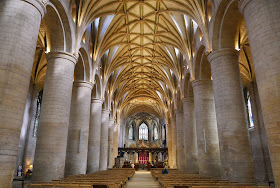Tewkesbury Abbey
The Abbey is Tewkesbury's greatest attraction, but there is lots else to enjoy. I am here to explore the town with my friend Merv/ We park near the Abbey, on a car park with warnings of its propensity to flood, and head there straightaway.
The first impression of a great, mainly Norman building and it was indeed started in 1087 and consecrated in 1121. The abbey was founded in 1107 before the completion of the church. The East end clearly has Gothic additions and these date from the 1400s.
Inside the Norman columns are solid and monumental, almost devoid of capitals. The centre rib of the roof has bosses representing the life of Christ.
Heading straight down the nave you come to the crossing, whose roof has a wonderful pattern of lierne vaults.
Beyond it lies the Quire with an even more astonishing roof. The lierne vaults here are overlaid with Yorkist badges of the sun in splendour. These commemorate the Yorkist victory over the Lancastrians at the battle of Tewkesbury in 1471.
The abbey was restored by Sir George Gilbert Scott in 1875-9 and his proposals so outraged William Morris that he founded the Society for the Protection of Ancient Buildings in protest.
Emerging into daylight, the next delight was the Russell Almshouses. They were founded 1674, rebuilt in 1831, modernised between 1958-1960 and re-instated in 1989. I have found nothing on why they were reinstated. Quite a pleasing group however.
Heading further west we came to the Abbey Gatehouse. It dates from the 15th/16th century and was restored in 1849. It is not very imposing.
We headed now towards the River Avon - this section is known as the Mill Avon. And here is the Abbey Mill, a flour mill which opened in 1865.
At the point we headed away from the river to join the High St and immediately noticed a number of impressive timber-framed buildings with large (larger than usual, we thought) jetties. This one, now a branch of the Halifax Building Society was especially good.
On the right, further along, was the first of many alleys for which the town is known. Merv thought they were related to the existence of long burgage plots (long but narrow pieces of land in a town). Such plots were often separated by alleys.
Back on the left hand side was the rather bijou Town Hall, built in 1788, enlarged about 1840 and altered in 1891 - and now the home of the Town (rather than Borough) Council
We now made another foray towards the river to see the imposing, but sadly derelict, Healings Flour Mill of 1865.
We returned again to the High St and turned left into Mythe Road, passing the closed down Old Black Bear pub. Being the oldest pub in Gloucestershire doesn't seem to have been enough to keep it going. Further along we crossed the Avon and admired the enormous 1930s pumping stations which try to manage the complicated water flows stemming from Tewkesbury's position where the Avon and the Severn converge.
Walking back we could see, the lock gates on the left, the small channel which joins the two.
We returned along Mythe Rd and turned right into the High St, taking a left to get a closer look at this rather striking church. It is Holy Trinity of 1837 by Ebenezer Trotman.
We reached Barton St and turned right to head back to the car along Church St. This street was distinguished by this exceptional terrace of half timbered houses. I have never seen anything like it.
Pevsner says that they were probably built by the monks of the abbey, and are therefore pre-Reformation, to let to tenants in the town as a speculative development. They would then be "one of the earliest surviving examples of uniform medieval town development".
Conditions: bright at first, becoming a bit greyer.
Distance: maybe three miles.
Map: Explorer 190 (Malvern Hills & Bredon Hill)
Rating: four and a half stars. An excellent day out.














No comments:
Post a Comment